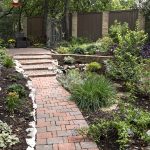One of the simplest ways to get rid of grass is to use the power of the sun.
If you’re ready to leave the lawn behind, summertime is the best time to get rid of it — permanently.
While many will turn to herbicides like glyphosate (aka Roundup) to finish it off for good, one of the simplest methods for permanently getting rid of grass is using the power of the sun.
The solarization process involves layering clear plastic over the grass to create a steaming greenhouse effect that will exhaust and kill it.
Gather your supplies:
- Lawn paint or a hose to outline the project area.
- Solarizing tarp or a roll of transparent 4-6 mil plastic sheeting cut to the shape of the future landscape bed. (Don’t use black or white plastic; they won’t create enough heat.)
- Bricks, rocks or lumber to fully weigh down the sheet.
- Lawnmower or string trimmer.
- Shovel.
- Once you’ve outlined the area, scalp the turf grass all the way to the ground with a mower or string trimmer.
- When you’re ready to apply the plastic, soak the area with water first. This will help create the “greenhouse effect” that will cook any emerging shoots.
- Now lay out the plastic as tight to the ground as possible, and carefully bury the edges to trap heat. Secure the sheet with bricks, rocks or lumber. Take your time with this step, as it’s important that the plastic not move or blow around for the duration of the solarization process.
Once installed, it will take 6-8 weeks of full sun and solarizing to fully kill the existing grass and reset your soil for planting. The more sun, the better of course. (A little shade won’t prevent solarization from working, but it won’t be as effective.)
While you’re waiting, keep a few things in mind:
- You must be patient. There will be a few weeks that you’ll have a big plastic sheet covering part of your landscape. While it may seem like an eyesore, remember it’s only temporary and the long-term results will be beautiful.
- Be careful not to damage or move the sheeting. Any rips, tears or removal of the plastic will reduce the effectiveness and may prevent solarization from working.
- Be dedicated. After solarization, you will have to be vigilant and remove any weeds as they begin to appear once the planting is done.
Remember no method of prepping landscape beds is 100% effective. Vigilance is always required against weeds that recur over time, even in mulch.
The advantage of solarization is that it doesn’t require herbicides or much digging. However, it does require a dedicated gardener willing to protect a plastic sheet, as well as time and sunshine — and these are in plentiful supply in summer.




